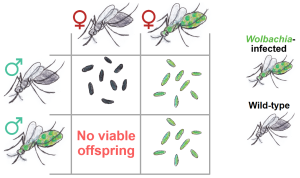This is an old revision of the document!
Table of Contents
Group 3
<html><font size=6 face=“Arial”>Title</font></html>
Wiki site of the practical exercise of the IX Southern-Summer School on Mathematical Biology.
Here you will find the exercise assignment and the group's products.
If you are a group member login to edit this page, create new pages from it, and upload files.
Introduction
Wolbachia are bacteria that infect a wide range of Arthopods. This particular bacterial infection is maternally inherited and often result on bacterial manipulation of host reproduction dynamics. One of the main host reproduction manipulations of Wolbachia is Citoplasmatic Incompatibility (CI).
CI occurs when males infected with Wolbachia mate with females that are not infected. Such a cross results in aborted fertilization. By contrast, infected females can mate successfully with both infected and uninfected males (Figure 1).
It is expected that the interplay between infected and healthy males and females can lead to different scenarios. In one extreme, Wolbachia succeeds and can even fixate permanently in the population. In other scenarios, Wolbachia might become its own executioner, leading to the collapse of the whole system. Nevertheless, other intermediate scenarios encompass males and females, infected or not, coexisting in the population.
Assignment
Propose and analyze a mathematical model to investigate the effect of a trait responsible for the proportion of offspring that is born infected with Wolbachia, as well as the effect of a trait related to male offspring mortality on invasiveness and dominance of Wolbachia infected host population.
Questions & Suggestions
- Investigate the system response to varying degrees of maternal inheritance of Wolbachia infection. How can infected host population establish and dominate?
- It has been proposed that Wolbachia infections can lead to the extinction of the male population (leading to the collapse of the whole system in some cases) [Merçot and Poinsot, 2009]. According to your model, in which situations does this collapse occur and how it can be avoided ?
- Considering a system composed only by infected males and females, can the healthy host phenotype invade the population? Is there a possibility of lasting coexistence of infected and uninfected individuals in the host population?
BONUS: consider a trade-off between maternal inheritance and offspring population size of infected hosts and explore parameter the regions in which Wolbachia can invade the population.
References
- Merçot, Hervé, and Denis Poinsot. “Infection by Wolbachia: from passengers to residents.” Comptes rendus biologies 332, no. 2-3 (2009): 284-297.
- Zug, Roman, and Peter Hammerstein. “Bad guys turned nice? A critical assessment of Wolbachia mutualisms in arthropod hosts.” Biological Reviews 90.1 (2015): 89-111.

